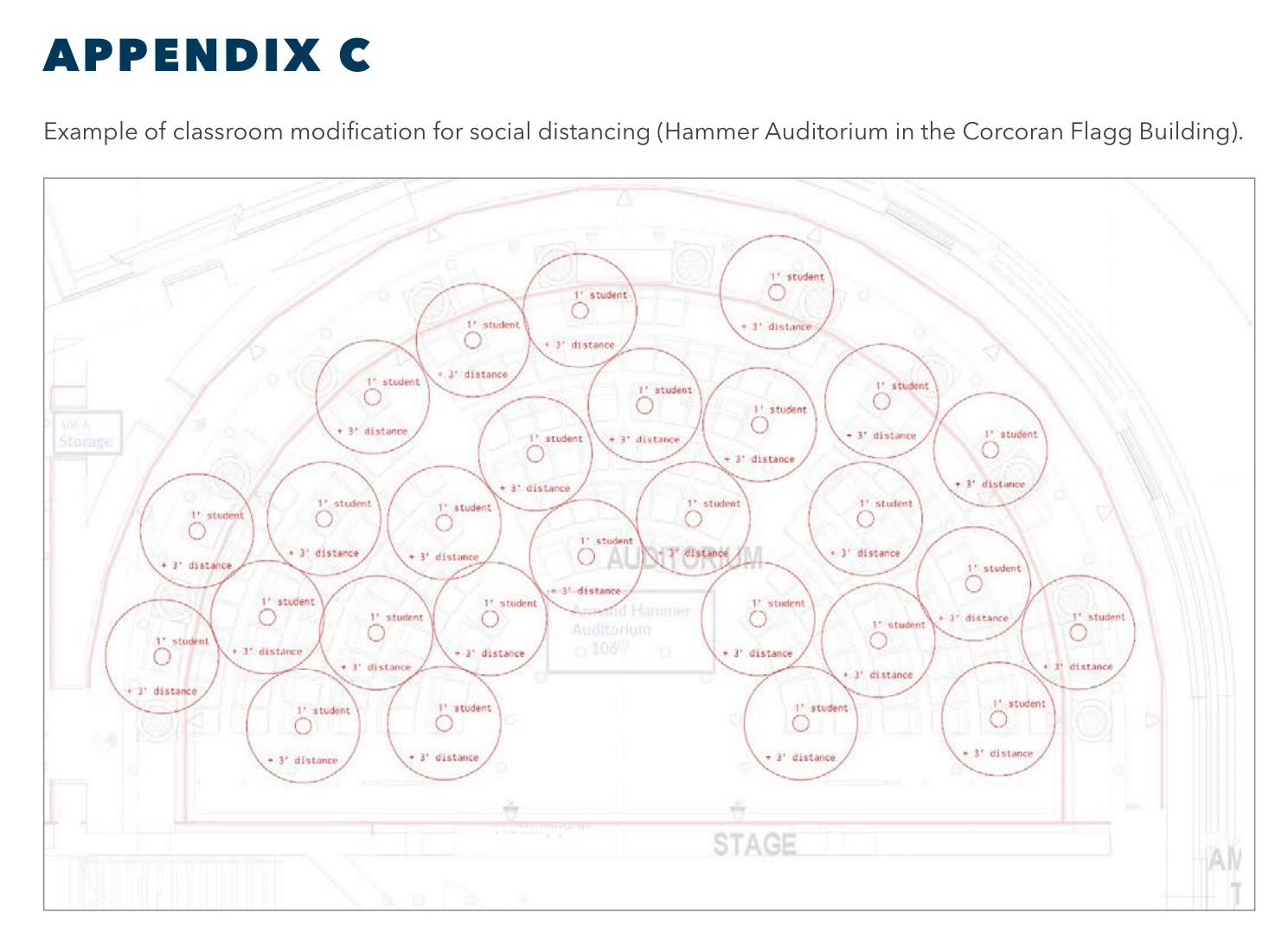
Media Credit: Hatchet File Photo
The analysis shows that a greater proportion of classrooms on the Mount Vernon Campus have the space needed to maintain proper distance compared to the Foggy Bottom Campus.
Less than a quarter of fall classes listed last month would allow for social distancing measures as officials move to modify classrooms before students return in August, a Hatchet analysis found.
Officials are spending a projected $3.6 million for “classroom modifications” to maintain six feet of space between students and faculty. A plan to hold in-person classes this fall from Aug. 31 to Thanksgiving is pending approval from D.C. officials.
The District’s second phase of reopening, which started last month, allows restaurants, businesses and places of worship to open at less than 50 percent capacity. Based on information from the Office of the Registrar and Banweb collected between June 13 and 19, a Hatchet analysis of 1,109 fall semester classes found that only 251 classrooms could operate at about half capacity if those classes were fully enrolled and all students attended in person.
The remaining 858 classes – about 77 percent – would not meet the 50 percent capacity requirement, which is generally meant to support social distancing measures and represents an estimate of the reduction in capacity needed to maintain distance between students in classrooms. Of those classes, 258 would be filled to the room’s maximum capacity if the class was fully enrolled.

George Washington University Plan for Fall 2020
Depending on the size of each classroom, the actual percent capacity needed to ensure proper distancing could be greater or lower than 50 percent, but this analysis assumes a uniform 50 percent is required across all classes.
This analysis was conducted by collecting class registration capacities on Banweb and matching those numbers with publicly available data on maximum room capacities, through school websites and the registrar’s office. All professors have the option to opt out of in-person classes and students can check the status of their classes through Banweb.
D.C. public schools are restricted to a more stringent requirement of 12 individuals per room in the District’s second phase. The average GW class size in this analysis is about 38 students.
Classes on the Mount Vernon campus seem to better allow for social distancing – 48 of the 65 classes held in Ames Hall, the Academic Building, Acheson Science Center and Eckles Library had enrollment caps that would fill less than half of the room’s maximum capacity.
Among departments, the University Honors Program’s classes were the most loosely spaced. If fully enrolled, 16 of the 24 classes The Hatchet was able to collect data on would be filled to less than 50 percent capacity.
| At more than 50% capacity | At less than 50% capacity | |
|---|---|---|
| 1776G | 1 | 0 |
| 1957E (Elliott School) | 144 | 30 |
| Academic Building (MVC) | 11 | 14 |
| Acheson Science Center (MVC) | 5 | |
| Ames Hall (MVC) | 24 | |
| Bell Hall | 61 | 14 |
| Corcoran Hall | 8 | 2 |
| Duques Hall | 101 | 10 |
| Flagg Building | 1 | |
| Funger Hall | 60 | 25 |
| Gelman Library | 31 | 11 |
| Hall of Government | 32 | 3 |
| Milken Institute School | 1 | 4 |
| Eckles Library (MVC) | 1 | 10 |
| Monroe Hall | 110 | 16 |
| School of Media & Public Affairs | 33 | 14 |
| Phillips Hall | 143 | 21 |
| Rome Hall | 46 | 31 |
| Science & Engineering Hall | 37 | 7 |
| Smith Hall | 16 | 11 |
| Tompkins Hall | 16 | 4 |
| At more than 50% capacity | At less than 50% capacity | |
|---|---|---|
| Accountancy | 22 | |
| American Studies | 8 | 5 |
| Anthropology | 9 | 3 |
| Applied Science | 8 | 1 |
| Arabic | 15 | 9 |
| Art History | 4 | 6 |
| Astronomy | 1 | 1 |
| Biological Sciences | 9 | 7 |
| Biomedical Engineering | 12 | 3 |
| Business Administration | 67 | 8 |
| Chemistry | 15 | 1 |
| Chinese | 10 | 4 |
| Civil Engineering | 11 | 2 |
| Classical Studies | 2 | 5 |
| Communication | 17 | 2 |
| Computer Science | 20 | 13 |
| Corcoran Continuing Education | 1 | 0 |
| Decision Sciences | 4 | |
| Economics | 48 | 1 |
| Electrical & Computer Engineering | 10 | 2 |
| English | 23 | 3 |
| English for Academic Purposes | 6 | 1 |
| Engr Mgmt & Systems Engineering | 9 | 1 |
| Environmental Studies | 1 | |
| Exercise and Nutrition Sciences | 1 | 1 |
| Film Studies | 1 | |
| Finance | 14 | 1 |
| French | 42 | 1 |
| Geography | 11 | 6 |
| Geology | 3 | 2 |
| Germanic Language & Literature | 12 | 4 |
| Greek | 0 | 2 |
| Health and Wellness | 1 | |
| Hebrew | 4 | |
| History | 34 | 7 |
| Honors | 8 | 16 |
| Human Services & Social Justice | 5 | |
| Inf Systems Technology Management | 3 | 2 |
| International Affairs | 57 | 14 |
| International Business | 11 | 3 |
| Italian | 1 | 4 |
| Japanese | 4 | 4 |
| Judaic Studies | 1 | 1 |
| Korean | 5 | 1 |
| Latin | 1 | 2 |
| Management | 1 | 1 |
| Marketing | 7 | |
| Mathematics | 24 | 4 |
| Mechanical & Aerospace Engineering | 17 | 1 |
| Naval Science | 4 | 1 |
| Organizational Sciences | 6 | 1 |
| Peace Studies | 1 | 1 |
| Persian | 3 | 2 |
| Philosophy | 18 | 2 |
| Physics | 1 | |
| Political Science | 74 | 5 |
| Psychology | 31 | 5 |
| Public Health | 2 | |
| Public Policy & Health Admin | 2 | 2 |
| Religion | 8 | 2 |
| School of Media & Public Affairs | 4 | |
| Slavic Languages and Lit | 10 | |
| Sociology | 12 | 5 |
| Spanish | 17 | 16 |
| Speech, Language and Hearing Sci | 9 | 3 |
| Statistics | 24 | |
| Sustainability | 2 | 1 |
| Theatre and Dance | 3 | 1 |
| Tourism Studies | 11 | |
| University Seminar | 8 | 3 |
| University Writing | 2 | 40 |
| Women and Leadership Program | 1 | |
| Women’s Gender & Sexuality Study | 8 | 3 |
Methodology
Data on classes was manually collected between June 13 and 19 using the schedule of classes and the University’s registration service on Banweb. The schedule of classes was used to create a preliminary list of all undergraduate classes, and then matched with Banweb registration to determine the maximum enrollment for each class.
Classes that could not be matched up between both the schedule of classes and Banweb using the course registration number or the course title were not included in this analysis. Classes without listed buildings or room numbers, including those that had “see department” listed in lieu of the class locations, were not included in this analysis.
Lifestyle, Sports and Physical Activity classes were not included in this analysis in light of their cancellation earlier this week. Classes in the music, anatomy and cell biology, emergency health services and University seminar sections of the schedule of classes were not included because no matching room capacities could be located.
Data on room capacities was largely collected from the Office of the Registrar’s list of classrooms available for reservation and for rent. Additional sources included the School of Business website and the School of Medicine and Health Sciences website, as well as PDFs from the registrar’s office and the Milken Institute School of Public Health.
Information on the Science and Engineering Hall’s and Flagg Building’s room capacities were found on the SEAS website and Corcoran website, respectively. Classroom capacities on the Mount Vernon Campus were reported using a registrar PDF. A second registrar document from academic year 2014-15 provided supplementary information.
The Hatchet was unable to locate the room capacities of about 80 rooms, largely in Phillips Hall, the Science and Engineering Hall, the School of Media and Public Affairs, and the Milken Science Institute School of Public Health.





